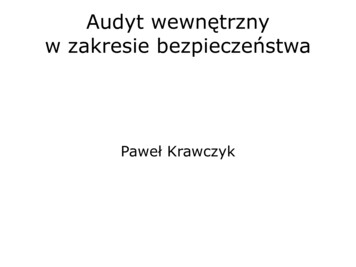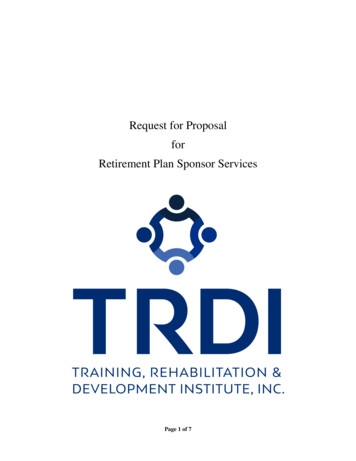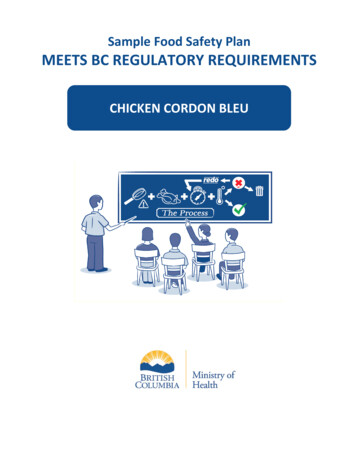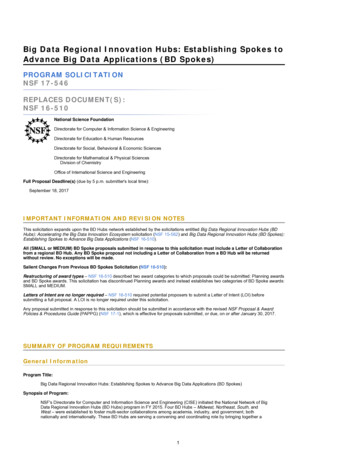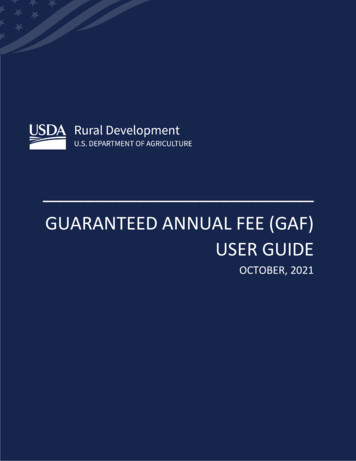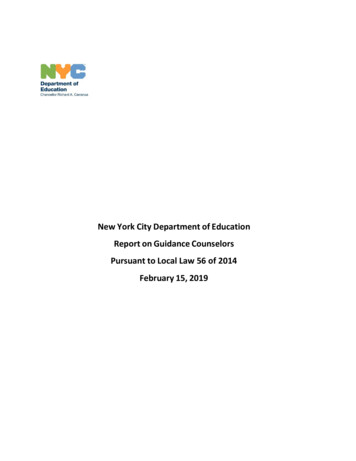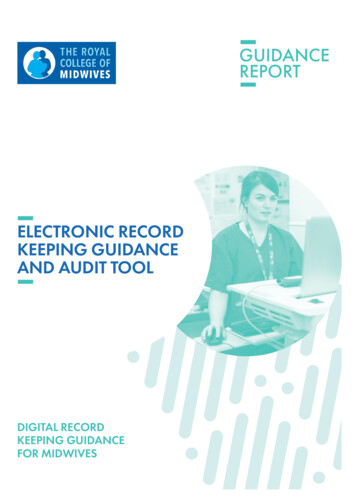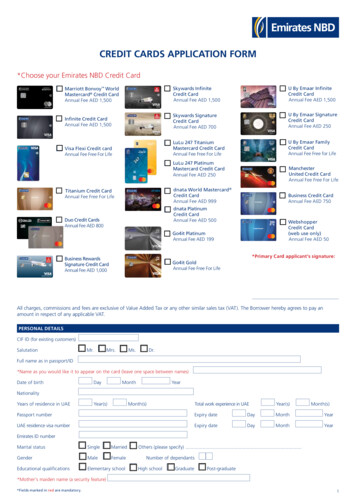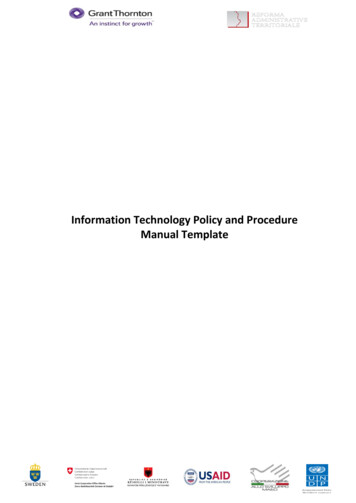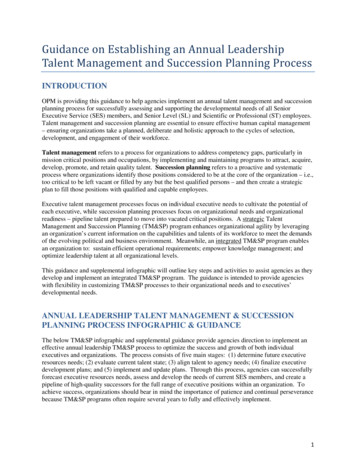
Transcription
Guidance on Establishing an Annual LeadershipTalent Management and Succession Planning ProcessINTRODUCTIONOPM is providing this guidance to help agencies implement an annual talent management and successionplanning process for successfully assessing and supporting the developmental needs of all SeniorExecutive Service (SES) members, and Senior Level (SL) and Scientific or Professional (ST) employees.Talent management and succession planning are essential to ensure effective human capital management– ensuring organizations take a planned, deliberate and holistic approach to the cycles of selection,development, and engagement of their workforce.Talent management refers to a process for organizations to address competency gaps, particularly inmission critical positions and occupations, by implementing and maintaining programs to attract, acquire,develop, promote, and retain quality talent. Succession planning refers to a proactive and systematicprocess where organizations identify those positions considered to be at the core of the organization – i.e.,too critical to be left vacant or filled by any but the best qualified persons – and then create a strategicplan to fill those positions with qualified and capable employees.Executive talent management processes focus on individual executive needs to cultivate the potential ofeach executive, while succession planning processes focus on organizational needs and organizationalreadiness – pipeline talent prepared to move into vacated critical positions. A strategic TalentManagement and Succession Planning (TM&SP) program enhances organizational agility by leveragingan organization’s current information on the capabilities and talents of its workforce to meet the demandsof the evolving political and business environment. Meanwhile, an integrated TM&SP program enablesan organization to: sustain efficient operational requirements; empower knowledge management; andoptimize leadership talent at all organizational levels.This guidance and supplemental infographic will outline key steps and activities to assist agencies as theydevelop and implement an integrated TM&SP program. The guidance is intended to provide agencieswith flexibility in customizing TM&SP processes to their organizational needs and to executives’developmental needs.ANNUAL LEADERSHIP TALENT MANAGEMENT & SUCCESSIONPLANNING PROCESS INFOGRAPHIC & GUIDANCEThe below TM&SP infographic and supplemental guidance provide agencies direction to implement aneffective annual leadership TM&SP process to optimize the success and growth of both individualexecutives and organizations. The process consists of five main stages: (1) determine future executiveresources needs; (2) evaluate current talent state; (3) align talent to agency needs; (4) finalize executivedevelopment plans; and (5) implement and update plans. Through this process, agencies can successfullyforecast executive resources needs, assess and develop the needs of current SES members, and create apipeline of high-quality successors for the full range of executive positions within an organization. Toachieve success, organizations should bear in mind the importance of patience and continual perseverancebecause TM&SP programs often require several years to fully and effectively implement.1
2
STAGE 1: DETERMINE FUTURE EXECUTIVE RESOURCES NEEDSObjective: The objective of Stage 1 is to develop a strategic workforce plan as part of mission strategythat outlines agency priorities based on future succession needs, anticipated organizational challenges,and projected turnover. Organizations should analyze current and future mission requirements, definecore competencies for leadership success, and identify critical leadership positions.Output:Succession Plan with: (1) identified targets that include the number of critical leadershippositions across the organization, and (2) the core leadership competencies required for thosepositions.Stage 1 Activities1. Conduct a comprehensive workforce analysis to identify potential gaps between theorganization’s current state and its desired future state. Table 1 highlights key workforceinformation to review and analyze.Table 1. Sample: Workforce Analysis InformationCurrent StateFuture StateExecutive workforce size (e.g., levels inthe leadership pipeline)Executive workforce deployment bylocations, function, occupation (e.g.,positions in mission critical occupationsversus all occupations)Leadership competencies needed formission accomplishmentAttrition, program dynamics, legislativechanges, organizational performanceplan, and budget on existing executiveposition structureExecutive resources requirements andchanges (e.g., biennial and interimallocation requests, restructuring ofexecutive positions)2. Identify the critical leadership positions, if vacant, would have a significant impact on theorganization’s ability to effectively function. Conduct a position risk assessment for eachposition to determine the level of effort and impact to replace the position incumbent. Positionswith a high and moderate level of risk and impact should be identified as critical leadershippositions. Assess the succession management risks 1 (see Table 2) for each critical leadershipposition.1Krishna, Shatrunjay. Succession Planning: The Answer to Leadership Crisis. Asian Management Review, JulySeptember 2014.3
Table 2: Sample: Succession Management RisksPosition Incumbent for X position:Low Risk,Minimal ImpactModerate Risk,Moderate ImpactHigh Risk, HighImpactVacancy Risk – What’s the risk andimpact of this being vacant over alonger period of time?Readiness Risk – What’s the risk andimpact of unprepared successors forthis position?Transition Risk – What’s the riskand impact of failure for an externalsuccessor in this position?Portfolio Risk – What’s the risk andimpact of poor deployment of talentagainst organizational needs?3. For each identified critical position, create a position inventory profile. The position inventoryprofile may include: Key job functions Critical job duties Core competencies (see Stage 1, Activity 4) Experiences necessary to be successful in the position Developmental opportunities4. Identify the core competencies (e.g., Executive Core Qualifications (ECQ) competencies andtechnical competencies) required to succeed in identified critical positions, and include thisinformation in the position inventory profile for each critical position. Integration of the corecompetencies into the TM&SP process enables the agency to ensure the assessment and advancedevelopment of potential successors, to mitigate transition risk.5. Using the information collected from Activities 1-4, complete a bench strength analysis todetermine if the agency has sufficient potential leaders at various levels that are ready to fill keyleadership positions. These results will help identify agency leadership development andrecruitment needs, determine potential sources of talent for meeting succession targets (e.g., SESCandidate Development Program (SESCDP) graduates or current SES members), and informtalent acquisition decisions. For additional bench strength analysis information and resources,please visit OPM’s Leadership Talent Management & Succession Planning Wiki page.6. Establish strategic alignment of the TM&SP process with the organizational strategy. Agenciesshould use the workforce and bench strength analysis results to highlight how the TM&SPprocess will support the agency’s mission, strategic goals, and operations. This alignment willreinforce a business case to obtain stakeholder buy-in and support of dedicated resources forsuccession management. It will also maximize the success of the agency’s recruitment andhiring, pipeline development and preparation, current and future skills gap and training needs,employee engagement and retention, and knowledge management and transfer.4
7. Use the information gathered from Activities 1- 6 to develop a succession management plan thatincludes the following components 2: Strategic requirements Succession management targets and talent pool analysis Strategies for recruiting, developing, and retaining leadership capacityFor Stage 1 resources & templates, please visit OPM’s Leadership Talent Management & SuccessionPlanning Wiki page.STAGE 2: EVALUATE CURRENT TALENT STATEObjective: Gather information on executives’ career interests and retirement plans, and determineexisting executive competence against what is needed to strengthen executive performance andorganizational success. Feedback must include input from the executive and the executive’s supervisor.Information will be used to recommend development activities.EXECUTIVEACTIONEach executive provides information to support the agency’s talent management andsuccession planning process, including career interests and retirement plans. Each executivemeets with his/her supervisor to discuss development needs and short-term and long-termcareer goals.Output: Comprehensive Talent Development Questionnaire Report for each executive,including feedback from the executive’s supervisor.Stage 2 Activities1. Develop a talent development questionnaire to assess executive competencies, identifystrengths and weaknesses, and map out career paths. The talent development questionnaire mayinclude the following elements: Executive’s key strengths (executives may use recent 360-degree assessment or otherleadership assessment results) Executive’s growth opportunities Executive’s accomplishments for each past position which highlight the identifiedcore competencies Any factors that could limit the executive’s advancement Core competency assessment Career interestso How long do you anticipate staying in your current role?o What job role do you aspire to in the next one to two years? Three to five years?o What development support do you need to reach your career goals? Expected retirement plans Number of years in current executive position2. The executive completes and submits his/her talent inventory/development questionnaire.2U.S. Office of Personnel Management. A Guide to the Strategic Leadership Succession Management Model,March 20095
3. The supervisor completes the talent development questionnaires to assess their executiveemployees’ competencies, identify developmental opportunities, and help map out options for theexecutives’ career path.For Stage 2 resources and templates, please visit OPM’s Leadership Talent Management & SuccessionPlanning Wiki page.STAGE 3: ALIGN TALENT TO AGENCY NEEDSObjective: The Executive Review Board (ERB) or similar body determines each executive’s “readinessstatus” and makes developmental and reassignment recommendations that align with the organization’sworkforce plan and the executive’s career goals. The ERB identifies a slate of internal candidates readyto fill critical positions to meet agency succession needs.Outputs: Thorough Talent Review Meetings conducted by the ERB Detailed Executive Feedback Reports highlighting executive readiness status and specificdevelopmental opportunities Internal Slate of Candidates with core competencies to fill critical positionsStage 3 Activities1. Conduct annual talent review meetings for each executive, with participation from the agency’sERB, to assess the future leadership capacity of the executive. Talent review meetings should beforward-looking and should focus on the executive’s long-term capability and success in futureroles rather than his/her performance in a current position. Talent review meetings should not beconducted simultaneously with performance appraisal reviews which focus on past performanceand actual accomplishments.2. Use the agency workforce plan, succession management targets, and talent inventoryquestionnaire responses to facilitate the talent review meetings involving each executive and theERB. ERB members should provide specific examples to support their comments andobservations. At the conclusion of each meeting, the ERB will reach consensus on the following: Readiness rating for each executive:o Ready for increased challengeo Ready for career broadeningo Build tenure/experienceo Contribute in place Individual strengths and areas of improvement, with specific examples illustrating eachidentified strength and area of improvement Recommended developmental opportunitiesReview Table 3 for a list of key questions and considerations to facilitate ERB talent reviewdiscussions.6
Table 3. Sample: Annual Talent Review Questions & ConsiderationsQuestions to Ask 3What is the executive’s likely next move?When should it happen?What does the executive need to developbefore making the move? ConsiderationsAdded responsibilitiesMove into a lateral roleExpanded responsibilities with significantchange in scale/scopeImmediateWithin the next yearNext 1-2 yearsReview core competencies listAdditional experiences3. Complete internal slate of candidates that includes a sufficient number of qualified executives tofill critical leadership positions. Each career path should highlight development and upwardmobility opportunities. Remember succession plans inform but do not dictate selection decisionsto fill executive positions in ways that benefit agency programs and each executive’sdevelopment.4. Complete individualized talent review meeting feedback reports for each executive that includesspecific development actions the executive must take to prepare for future roles with a higherlevel of responsibility and/or difficulty.For Stage 3 resources and templates, please visit OPM’s Leadership Talent Management & SuccessionPlanning Wiki page.STAGE 4: FINALIZE EXECUTIVE DEVELOPMENT PLANObjectives: Present feedback, from the ERB or similar body, to each executive on current career growthstatus, future career possibilities, and recommended development activities. The executive’s supervisorworks with the executive to update and finalize an Executive Development Plan (EDP). Collect finalEDPs.EXECUTIVEACTIONEach executive works with his/her supervisor to include recommendations from the ERB orsimilar body in his/her final EDP. Each executive submits his/her finalized EDP to thedesignated agency contact and makes preparations to complete the developmental activitiesoutlined in his/her plan.Outputs: Comprehensive Talent Review Meeting Debriefs with all executives Finalized EDPs for all executivesStage 4 Activities1. The supervisor of an executive conducts talent review meeting debrief with individual executivesto provide developmental feedback. Talent review meeting debriefs should emphasize theexecutive’s potential based on the ERB’s talent review meeting feedback report and the talentdevelopment questionnaire responses.3Society for Human Resource Management. Succession Planning. 2015.7
2. The executive and his/her supervisor determine specific development opportunities that addressorganizational and individual needs, and may use the following five types of leadership developmentinterventions and learning activities4:Instructor-led Facilitated by an instructor either online or in a classroom setting Allows for learners and instructors or facilitators to interact and discuss the training material, eitherindividually or in a group setting Examples: degree programs, courses, seminars, workshops, case presentations and discussions,distance learning, and passive computer-based instructionExperiential activities Developmental tasks that occur in immersive environments and allow learners to naturally generatequestions Hands-on learning and conversation are key; either virtually or in face-to-face interaction Examples: rotations, on-the-job training, action learning, service learning, cross agency task forces,intergancy task forces, team projects, simulations and games, and scenario planningDevelopmentalrelationships Either formal or informal relationships that involve one individual taking an active interest in andinitiating actions to advance another’s development Serve as key sources of assessment, challenge, and support. Examples: coaching, mentoring, networking, supervisor support, peer-to-peer learning partners, andshadowingMultisource feedback Process of acquiring performance feedback from multiple rates and sources, including a leader'ssuperiors, peers, and subordinates. Leaders also provide self-ratings. Feedback is intended to foster greater self-understanding and facilitate the construction of effectiveindividualized development plansSelf-development Any self-initiated and proactive learning process where learners are responsible for (a) assessing theirown strengths and developmental needs, (b) designing and completing their instructional curriculum,and (c) evaluating their own learning progress Examples: executive development plans, and self-guided learning activities3. The executive completes and submits a finalized EDP to the designated agency contact, and forERB review.For Stage 4 resources and templates, please visit OPM’s Leadership Talent Management & SuccessionPlanning Wiki page.STAGE 5: IMPLEMENT AND UPDATE PLANSObjective: Use recommendations from the ERB or similar body to fulfill agency succession needs andstrategically fill vacant positions. Monitor and evaluate talent management and succession plan asappropriate to meet changing organizational needs.Each executive completes the developmental activities outlined in his/her EDP. Each executiverevises his/her EDP as appropriate to meet changing career goals and development veloping-ecqs.pdf8
Outputs: Comprehensive list of metrics for periodic evaluations of TM&SP plan.Stage 5 Activities1. Monitor the implementation process by identifying key implementation milestones to measureinterim results.2. Create a list of metrics to track progress and results. Possible metrics include: Number of critical positions filled with internal versus external candidates % of critical positions with multiple identified successors % of executives with signed and completed EDPs % of executives participating in at least one developmental activity % of executives with completed developmental needs assessments Time-to-fill critical positions Executive retention and turnover percentage Executive satisfaction with TM&SP process Diversity metrics of SES corps (gender, race, ethnicity)For a comprehensive list of metrics, please review the Logic Model Template for LeadershipTalent Management and Succession Planning (TM&SP) Process in the Appendix.3. Revise TM&SP plan as needed to meet organizational needs and political climate. Periodicevaluations should take the following into account: Extent to which the organization has successfully accomplished its succession targets andtalent management objectives Changes in program priorities and emphasis, as reflected in budget or legislativedevelopments, the vacancy attrition rate, or other indicators The number of vacant SES positions in the organization, and the length of time they havebeen vacant SES position review to either reaffirm or adjust the distribution of executive resources soas to be most responsive to the agency’s current requirements4. Communicate TM&SP process progress to all stakeholders.For Stage 5 resources and templates, please visit OPM’s Leadership Talent Management & SuccessionPlanning Wiki page.9
ESTABLISHING & SUSTAINING A LEADERSHIP TALENT MANAGEMENTAND SUCCESSION PLANNING PROCESS AT YOUR AGENCYCurrently, Federal agencies are implementing TM&SP processes with varying degrees of maturity. Onone end of the spectrum are agencies with fully developed and goal-based TM&SP processes that occuron a regular basis (e.g., annually). On the other end are agencies with nonstrategic and unplannedprocesses and activities. It takes a couple of years to fully develop and implement a strategic TM&SPprogram. As part of continuous improvement efforts, agencies should also consider the alignment of thefollowing factors with the organizational strategy: Inclusive Succession Plan – Is your succession plan operational? Is the current approach tosuccession planning only focused on identifying immediate replacements? It’s important toassess all potential gaps in the immediate and emerging needs of the organization (e.g., legislativechanges, budget, new programs, new SES positions/allocations, and attrition). Strategicsuccession plans will address short-term, intermediate and long-term executive staffing needs. Astrategic succession planning process enables an organization to seamlessly merge executivecapability with organizational talent needs and strategy. For more information on successionplanning visit: pital-management/talent-management/#url Overview.5 Talent Acquisition Strategy – Is the time-to-hire metric unknown or perceived by executivesupervisors as too long? Are you using appropriate Qualification Review Board (QRB)submission methods that are most effective for the agency’s successful SES hiring andaccomplishment of mission? Time-to-hire is a critical metric for planning purposes, andreporting of this metric is required by OPM 5. In addition to time, the method in which anexecutive is hired (e.g., Resume, Accomplishment Record, or ECQ write-up) will influencerecruitment of exceptional leaders. Strategic talent acquisition decisions will attract the righttalent and increase the percentage of executive supervisors reporting satisfaction with new hires.For more information on SES Hiring Reform, please review OPM’s Guidance on QualificationsReview Board Submission Methods. Executive Development Accountability – How many executives are completing executivedevelopment plans (EDPs)? How are executives held accountable for implementing EDPs? ng-requirements10
EDPs linked to the agency’s performance management system? A strategic EDP processproduces executives capable of “re-tooling” themselves to meet the demands of constantorganizational and enterprise-wide change. All effective TM&SP processes incorporateexecutive development plans (EDPs) that support the executive and help the organization achieveits mission, vision, and strategic goals. For EDP help and guidance visit OPM’s ExecutiveLearning and Development Wiki page. Human Capital Ownership – Who is (or would be) responsible, accountable, consulted, andinformed in the development and implementation of TM&SP? How are stakeholder roles andresponsibilities determined (e.g., Agency Head, Executive Resources Board (ERB), ExecutiveResources (ER), etc.)? Senior leadership support is critical to the success of the TM&SP process.The best processes, include and clearly define, in writing, all representatives from the various HRelements critical to ensuring appropriate linkages in the process (e.g., performance management,learning, recruitment, staffing). Please review OPM’s Job Aid: Creating a ParticipatorySuccession Management Infrastructure for more information on how to identify key stakeholderroles and responsibilities.At a minimum, agencies must develop a program with a structured succession planning process, talentacquisition strategy, and executive development process. Agencies must also ensure leadership haveawareness, participate, and are held accountable for results in these three areas. Where deficits exist,these areas must be strengthened before embarking on full TM&SP program implementation, which willmake the activities easier in the following years of this annual process.11
Appendix12
Logic Model Template for Leadership Talent Management and Succession Planning (TM&SP) ProgramProgram Office Goal:Business Objective:Assumptions:Develop a comprehensive TM&SP framework to improve strategic executive resources decisions.Enhance individual and organizational performance through the alignment of talent management and succession planning practices with the organizational strategy.Supervisors’ are aware of their executives’ strengths and weaknesses; executives perceive senior leaders as supportive of their development; diversity plays no role in the way motivation andambition is expressed; once in the position, qualified executives need no strategic onboarding to be quickly successful.What Resources do you needto run the program?Inputs Talent Management &Succession PlanningCoordinator (with projectmanagement skills)-to lead theprocess, ensure activities arecompleted and for coordinationAppropriate Human Resources(HR) offices to ensure properlinkages with SES Onboarding& other programs (e.g.,executive resources,performance management,learning, recruitment, staffing,diversity and inclusion)Process Champion (to removeroadblocks and help ensureparticipation)Agency’s Executive ResourcesBoard (ERB)ExecutivesExecutives’ SupervisorsTimeMeeting Space (e.g. gapanalysis mtgs., talent reviewmtgs., action planning)Budget (e.g., technology,consultants, materials, traininginvestment to ensureappropriate and structuredlearning)What you will do with theresources?ActivitiesPlanning Phase Changes/impacts that occur because of program activities*****OUTCOMES***** Determine readiness to implement aLeadership TM&SP processAddress readiness issues (if any)Establish a formal policy or StandardOperating Procedures (SOPs) thatclearly identify process goals,stakeholder roles, timelines, criticalsuccess factors, tasks, activities andrisksDevelop an evaluation planCreate a communication plan (withpurpose, activities and end results ofTM&SP Process)Implementation Phase Conduct comprehensive workforceanalysisIdentify critical leadership positions &core competenciesCreate position inventory profilesComplete the bench strength analysisDevelop a succession managementplanDevelop talent developmentquestionnaireConduct talent review meetings withERB or similar bodyComplete internal slate of candidatesto fill critical leadership positionsComplete executive feedback reportsbased on talent review meetingsTalent review meeting debriefconducted by supervisorExecutives’ finalize executivedevelopment planTrain managers, executives andleaders on their roles in the processand educate them on the benefitsmoving forwardImplement Communication PlanImplement the Leadership TM&SPprocess consistently throughout theagencyIntermediate3 months outShort-term Executives areaware of their needfor development(or their solidperformance butdesire to stay inplace) and, withfeedback andsupport of seniorleaders, engage inleadershipdevelopment,knowledge transfer,or performancemanagementExecutives areaware of theirgrowth potentialand, with feedbackand support ofsenior leaders,participate inintegratedleadershipdevelopmentactivities linkingindividual needswith agency goals,with successionplanning for keyrolesExecutives areaware of theirreadiness toadvance andmaintainengagement andeffectiveness in theagency successionpipeline Clear talent poolsidentified; leadershippipelines supportcritical positionsHigh performingexecutives and theirstaff are engaged insupporting theagency missionQualified candidatesin the successionpipeline apply forcritical leadershippositions in acompetitiverecruitment andhiring processEnhancedcommunications andcollaboration amongHR offices and ERBExecutivedevelopmentcurriculums addressexecutive needsWhat will show you're getting there?You should have baseline data for each evaluation method usedLong-term1 year OutputsPlanning PhaseExecutiveImproved individualperformanceIncreased engagementImproved personalaccountability fordevelopmentExecutive’s SupervisorOptimized talentallocationSatisfaction withquality of applicantsEnhancedcommunications withemployeesEquipped to developemployees Senior leaders timespent reviewingmaterialsFormal TM&SP policyor SOPTM&SP evaluation planTM&SPcommunication plan#of supervisors andleaders trainedProcess Evaluation Implementation Phase OrganizationEngaged and involvedERBBroad and deepinternal leadershippipelineInclusive, transparent,and ongoing tency gapsclosed for missioncritical occupationsImproved Time-toHireReduced voluntaryturnover of talentedexecutivesImproved retentionImproved customerserviceReduced # of vacantSES allocationsEvaluation Methodology Workforce AnalysisPosition inventoryprofilesBench strength analysisSuccession managementplan (with identifiedtargets for criticalleadership positions)Talent developmentquestionnaire# of completed talentdevelopmentquestionnaires# of talent reviewmeetingsExecutive selfassessments# of executive feedbackreports#of talent reviewmeeting debriefs# of executivedevelopment plans# of executivesparticipating in TM&SPExecutives satisfactionDegree of policyimplementationHow well is the process operating – therelationship between inputs, activities, outputs,and outcomesWhat resources have actually been allocated ormobilized?Which activities are actually taking place?Who is conducting the activities?Who is being reached through the activities?Which areas need improvement?Impact Evaluation To what degree have objectives/outcomes beenachievedPotential gaps in planning and assumptionsData Collection Tools Document review (EDPs, SES retention, SESperformance plans, SES performance ratings,etc.)InterviewsSurveysFocus GroupsObservation13
2. Use the agency workforce plan, succession management targets, and talent inventory questionnaire responses to facilitate the talent review meetings involving each executive and the ERB. ERB members should provide specific examples to support their comments and observations.

